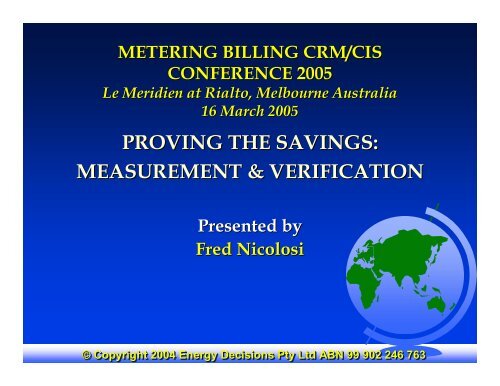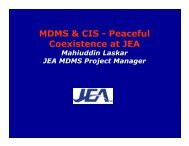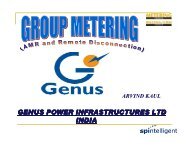MEASUREMENT & VERIFICATION
Fred Nicolosi - Metering.com
Fred Nicolosi - Metering.com
- No tags were found...
Create successful ePaper yourself
Turn your PDF publications into a flip-book with our unique Google optimized e-Paper software.
METERING BILLING CRM/CIS<br />
CONFERENCE 2005<br />
Le Meridien at Rialto, Melbourne Australia<br />
16 March 2005<br />
PROVING THE SAVINGS:<br />
<strong>MEASUREMENT</strong> & <strong>VERIFICATION</strong><br />
Presented by<br />
Fred Nicolosi<br />
© Copyright 2004 Energy Decisions Pty Ltd ABN 99 902 246 763
What I Will Talk About<br />
Evolution of M&V Protocols and Guidelines<br />
Australian Best Practice Guide to M&V<br />
M&V Concepts and Methodologies<br />
M&V Plan<br />
M&V Options<br />
Energy Savings Determination<br />
Cost Avoidance<br />
M&V Examples<br />
Questions
About Fred Nicolosi<br />
Electrical Engineer (light current)<br />
BE, MEngSc, MBA, CMVP<br />
Certified Measurement and Verification Professional<br />
- http://www.ipmvp.org/cmvplist<br />
25 years in Queensland electricity industry<br />
- power system control, SCADA, metering and communications<br />
5 years in Qld Govt<br />
- Director of Queensland Telecommunications<br />
2 years in Qld software company<br />
– Utility Customer Information and Billing Systems<br />
Provider of Energy Information Products and Service<br />
since 1998
Evolution of M&V Protocols & Guidelines
Australian Best Practice Guide for M&V<br />
BPG-M&V Objectives<br />
• Improved M&V Understanding – especially Energy Users<br />
• Improved M&V Precision and Quality<br />
• Improved M&V Cost/Benefit/Value<br />
• Establish Minimum Acceptable M&V Implementation<br />
• Facilitate Operational Implementation<br />
• Promote M&V for Public and Private Sector Use<br />
BPG-M&V<br />
- Applicable Parts for Australia<br />
• IPMVP – ”The Bible”<br />
http://www.ipmvp.org/<br />
• ASHRAE Guideline 14-2002<br />
– Measurement of Energy and<br />
Demand Savings<br />
• FEMP - Federal Energy Management Program M&V Guidelines<br />
• Other Overseas M&V Publications
BPG-M&V Project Status and Funding<br />
The Australian Government's Innovation Access Program - Industry<br />
provides grants for industry-led projects as part of it's support for<br />
innovation, investment and international competitiveness of<br />
Australian businesses. Industry and Customer Consultation<br />
Funds provided by AusIndustry to AEPCA<br />
Contracted to AEPCA to author BPG-M&V<br />
Stakeholder’s s Group for guidance and consultation<br />
Current Status – Final Release in January 2005<br />
Future updates to incorporate continuing M&V<br />
developments and user feedback<br />
Visit http://www.aepca.asn.au/
M&V for Energy Savings Projects<br />
Any Type, EPC, In-House or Multi-Site<br />
Projects<br />
Site-specific energy savings projects<br />
Different to Rating, Benchmarking, and<br />
Targeting<br />
Savings Over Time Pays for Retrofit Costs<br />
EPC Process<br />
Project Implementation Phases<br />
• Baseyear Period – Planning & Design - M&V Plan and<br />
Baselines<br />
• Installation Period – Construction & Commissioning<br />
• Performance Period – Savings Reconciliation
Simplified Energy Savings Project Scenario
Measurements for Energy Savings Projects
Energy Savings Determination
Energy Savings Determination<br />
During Baseyear Period, Create and Agree<br />
• Baseyear Measurements & Calculation Methods<br />
• Baseyear Conditions and Assumptions<br />
• Create Baseyear Model to be used to calculate Baseline Energy for<br />
Performance<br />
During Performance Period<br />
• Calculate Baseline Energy that Would Have Been Consumed<br />
If ECMs Had Not Been Installed<br />
• Adjust Baseline Energy for Other Changes in Conditions and<br />
Assumptions<br />
• Measure Actual Energy Consumed with ECMs Installed<br />
For Current Period<br />
• Achieved Savings = Adjusted Baseline – Post-Retrofit Actual<br />
• Savings Reconciliation = Guaranteed Savings – Achieved Savings
Importance of M&V Plan<br />
An M&V Plan is mandatory<br />
When should the M&V Plan be<br />
developed<br />
How to develop an M&V Plan<br />
Who should prepare the M&V Plan<br />
Who should verify the M&V Plan<br />
adherence
IPMVP M&V Options<br />
Realized Savings = f (Performance, Operation)<br />
Responsibility Sharing for Performance and Operation<br />
Option A - Partially Measured Retrofit Isolation<br />
• Partial short-term/continuous term/continuous measurements – some but not all stipulated<br />
• For Separable ECM Savings Determination - Lighting<br />
Option B - Retrofit Isolation<br />
• Full short-tern tern or continuous field measurement - no stipulations<br />
• For Separable ECM Savings Determination - HVAC subsystem<br />
Option C - Whole (or Part) Building<br />
• Full continuous energy use and demand measurement during Baseline e and<br />
Post- Retrofit Periods<br />
• Collective Savings of all ECMs for Area monitored by a Single Meter<br />
Option D – Calibrated Simulation<br />
• Computer-based simulation of energy use of building components<br />
• Simulation Calibration, Considerable skills, Costly ????
Option C - Baseyear Model Creation<br />
kWh = (34,609.8 x Days) + (4,666 x HDD) + (4,440.6 x CDD)
Importance of Measurements<br />
Use Best Practice for each specific energy measurement<br />
situation<br />
Minimise inherent errors & avoid data management errors<br />
Billing and Smart Meter Data from Utilities<br />
- advantages and difficulties<br />
Sub-metering may be required - advantages and disadvantages<br />
Other Data – Weather, Areas, Occupancy, Production Levels<br />
Need policies, practices and business processes to assure<br />
completeness, timeliness and quality of the energy<br />
measurements and other data
Cost Avoidance<br />
Cost Savings = Quantity Savings x Price<br />
• Baseline Adjustments Reduce Energy Quantity Risks<br />
• Neither Party Controls Price Risk on Cost Savings<br />
When Prices Go Down<br />
• Customer Benefits from Reduced Billed Charges<br />
• Cost Savings Reduced – Cost Savings Risk Impact ???<br />
When Prices Go Up<br />
• Customer Pays Higher Billed Charges<br />
• Cost Savings Increased – Cost Savings Risk Impact ???<br />
Selecting the Price – Use Current Price ???<br />
Use Agreed Stipulated Prices to Remove Price Risk
Case 1: Water Savings Performance<br />
Baseline kL = f (Days)<br />
Goodness of Fit = 00.0%
Case 2: Gas Savings Performance<br />
Baseline MJ = f (Days, Heating Severity)<br />
Goodness of Fit = 96.0%
Case 3: Water Baseline Adjustment<br />
Baseline kL = f (Days)<br />
Goodness of Fit = 00.0%
Case 4: Energy Baseline Creation<br />
Baseline kWh = f (Days, Cooling Severity)<br />
Goodness of Fit = 57.3%
Case 4: Energy Baseline Creation<br />
Baseline kWh = f (Days, Cooling, Occupancy)<br />
Goodness of Fit = 85.3%
Case 5: Portfolio Energy Savings<br />
Comparative Monthly Consumption<br />
Base Year = 2000/2001 Reporting Year = 2001/2002
Cases 5: Portfolio Energy Savings Performance<br />
Annual & Monthly Cooling Severity Comparison<br />
Base Year = 2000/2001 Reporting Year = 2001/2002
Case 5: Portfolio Energy Savings – Base Year<br />
Baseline Energy (kWh) = f (Days, Cooling Severity)<br />
Goodness of Fit = 99.2%
Case 5: Portfolio Energy Savings - Reporting Year<br />
Can Agency take credit for apparent energy reduction ???
Case 5: Energy Savings Reporting Errors<br />
Non-Adjusted Energy Savings<br />
Actual Consumption for 2000/2001 in kWh 1,605,138<br />
Actual Consumption for 2001/2002 in kWh 1,197,135<br />
Consumption Reduction before Weather Correction 408,003<br />
Percentage Reduction relative to Base Reference Year………<br />
………..…..25.42%..25.42%<br />
Adjusted Energy Savings<br />
Estimated Baseline Energy for 2001/2002 in kWh 1,079,412<br />
Actual Consumption for 2001/2002 in kWh 1,197,135<br />
Consumption Increase After Weather Correction 117,723<br />
Percentage Increase relative to Weather-Corrected Baseline……<br />
……..10.91%
Concluding Messages<br />
Adopt proven and trustworthy M&V policies<br />
and practices for energy savings projects<br />
Adopt proven and trustworthy policies and<br />
practices for determining Energy Baselines for<br />
reporting energy savings<br />
Adopt proven policies and practices to assure<br />
the completeness, timeliness and quality of the<br />
energy data<br />
Use the Best Practice Guide for M&V as your<br />
starting point – it is an AEPCA free issue
Questions ?












